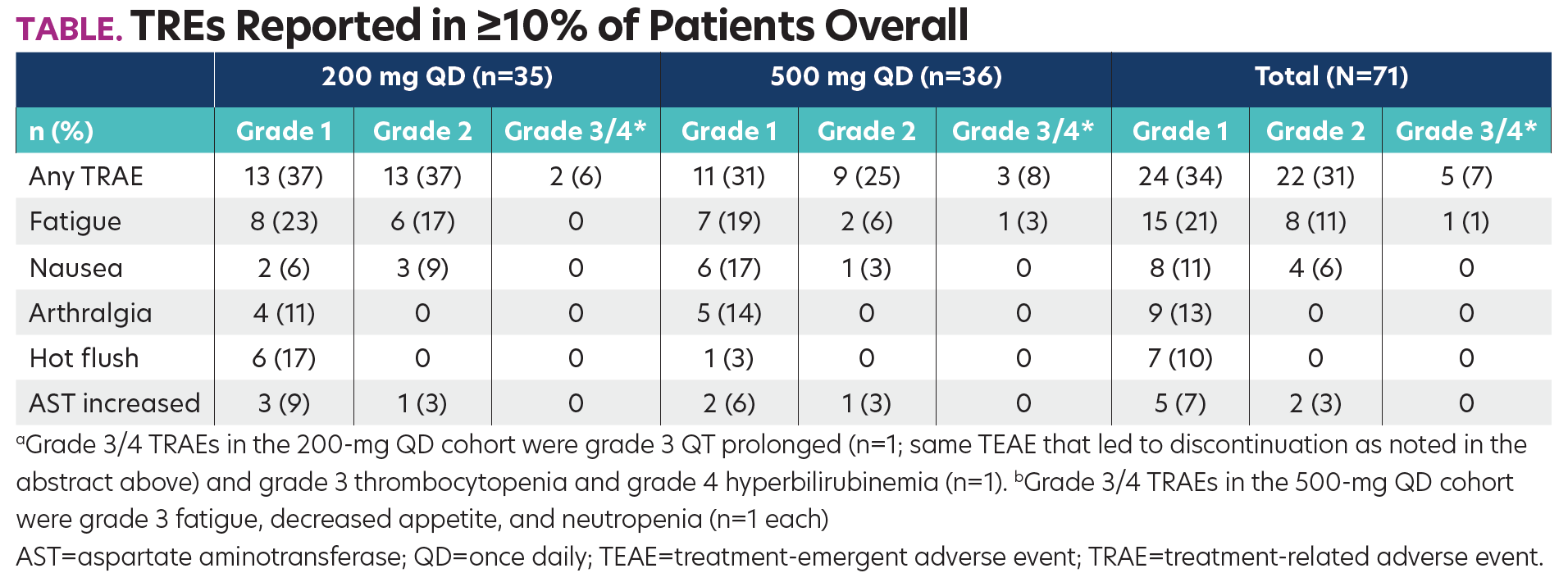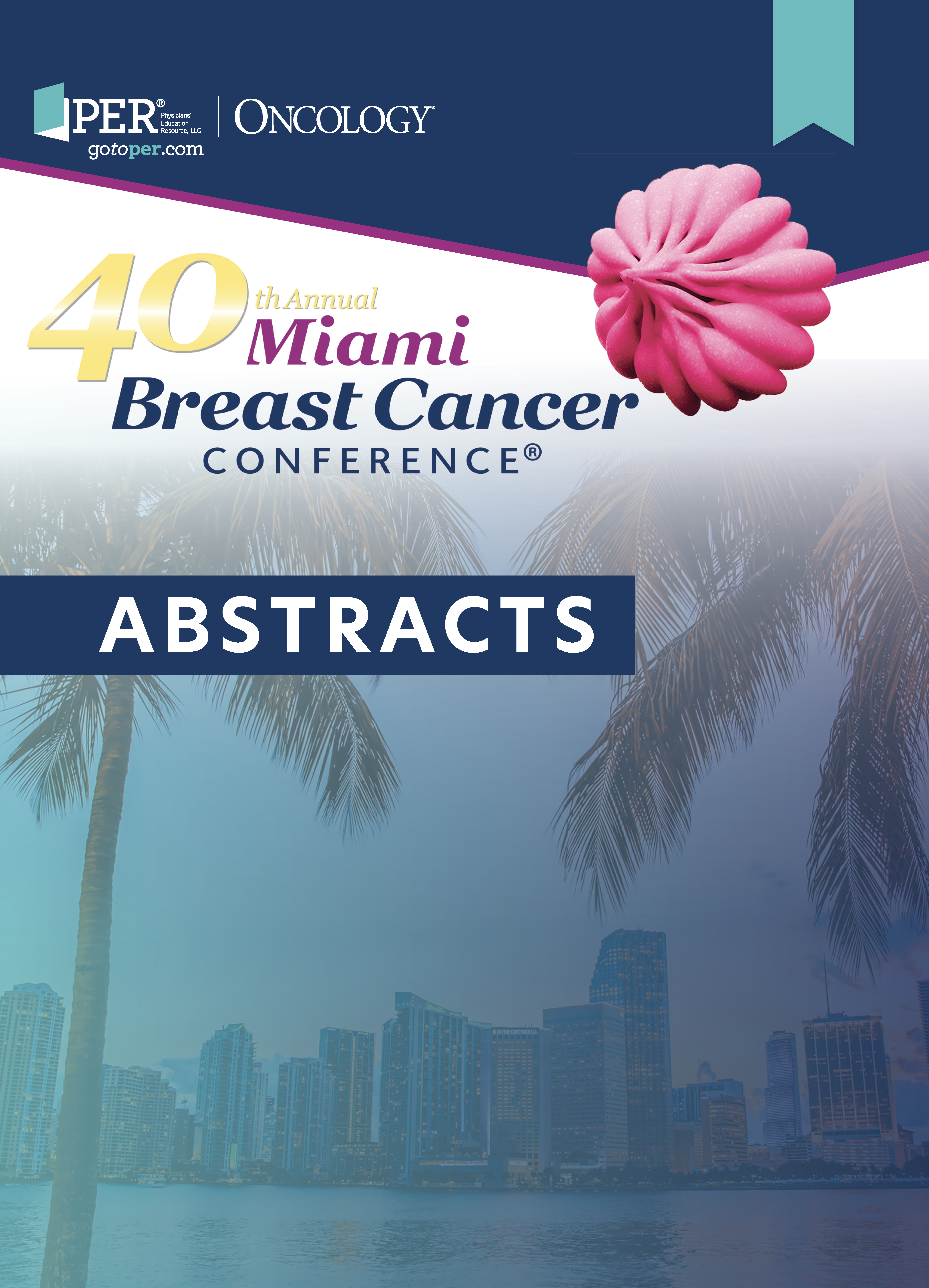24 ARV-471, a PROTAC Estrogen Receptor (ER) Degrader in Advanced ER+/Human Epidermal Growth Factor Receptor 2 (HER2)– Breast Cancer: Phase 2 Expansion (VERITAC) of a Phase 1/2 Study
TABLE. TREs Reported in ≥10% of Patients Overall

Background
ARV-471 is a selective, orally administered PROTAC protein degrader that targets wild-type and mutant ER1. ARV- 471 directly binds an E3 ubiquitin ligase and ER to trigger ubiquitination of ER and its subsequent proteasomal degradation. In contrast, selective estrogen receptor degraders (SERDs) indirectly recruit the ubiquitin-proteasome system, secondary to conformational changes and/or immobilization of ER2. Limitations of the SERD fulvestrant include its intramuscular route of administration and only 40%–50% ER protein degradation at its optimal dose. ARV-471 treatment yielded substantially greater ER degradation and tumor growth inhibition than fulvestrant in breast cancer xenograft models. ARV-471 is being evaluated alone or in combination with palbociclib in previously treated patients with ER+/HER2– locally advanced/metastatic breast cancer in a first-in-human phase 1/2 study (NCT04072952). Here we present the initial outcomes of the phase 2 cohort expansion (VERITAC), which is investigating ARV-471 at doses of 200 mg QD or 500 mg QD in pretreated patients with ER+/HER– locally advanced/ metastatic breast cancer.
Materials and Methods
Key eligibility criteria for VERITAC:
- Histologically or cytologically confirmed ER+ and HER2– advanced breast cancer
- Measurable or nonmeasurable disease per Response Evaluation Criteria in Solid Tumors (RECIST) v1.1
- ≥1 prior endocrine regimen (≥1 regimen for ≥6 months in the locally advanced or metastatic setting)
- ≥1 prior CDK4/6 inhibitor
- ≤1 prior chemotherapy regimen in the locally advanced or metastatic setting
Outcome measures:
- Primary end point was CBR (rate of confirmed complete response or partial response [PR] or stable disease ≥24 weeks) analyzed in patients enrolled for ≥24 weeks prior to the data cutoff
- Secondary end points included overall response rate, duration of response, progression-free survival (PFS), and overall survival, safety, and pharmacokinetic parameters
- ESR1 mutational status and ER protein levels were exploratory end points
Results
As of June 6, 2022, 71 pts received ARV-471 (200 mg QD, n = 35; 500 mg QD, n = 36) in VERITAC; 69 (97.2%) pts were female and median age was 60 years (range, 41–86). Pts had received a median of 4 prior regimens (range: 1–10; 100% prior CDK4/6 inhibitors, 78.9% prior fulvestrant, and 73.2% prior chemotherapy). ARV-471 was well tolerated at both doses, with most treatment-related adverse events (TRAEs) grade 1/2 (Table). Three pts (200 mg QD, n = 1; 500 mg QD, n = 2) discontinued ARV-471 due to treatment-emergent AEs (TEAEs); 3 pts had ARV-471 dose reductions due to TEAEs (all from 500 mg QD to 400 mg QD). CBR was 37.1% (95% CI, 21%–55%) in 35 evaluable pts at 200 mg QD and 38.9% (95% CI, 23%–57%) in 36 evaluable pts at 500 mg QD. In evaluable pts with mutant ESR1 at 200 mg QD (n = 19) and 500 mg QD (n = 22), CBR was 47.4% (95% CI, 24%–71%) and 54.5% (95% CI, 32%–76%), respectively.
Conclusions
In the phase 2 VERITAC expansion cohorts, ARV-471 monotherapy showed evidence of clinical activity based on CBR, including in the subgroup with ESR1 mutations, and a manageable safety profile. ARV-471 200 mg QD was selected as the phase 3 monotherapy dose based on comparable efficacy, favorable tolerability, and robust ER degradation. The phase 3 VERITAC-2 study (NCT05654623) is evaluating ARV-471 200 mg QD vs fulvestrant as second-line therapy in patients with ER+/HER2– advanced breast cancer who previously received 1 line of CDK4/6 inhibitor therapy in combination with endocrine therapy.
AFFILIATIONS:
Sara A. Hurvitz,1 Anne F. Schott,2 Cynthia Ma,3 Erika P. Hamilton,4 Rita Nanda,5 George Zahrah,6 Natasha Hunter,7 Antoinette R. Tan,8 Melinda L. Telli,9 Jesus Anampa Mesias,10 Rinath Jeselsohn,11 Pamela Munster,12 Haolan Lu,13 Richard Gedrich,13 Cecile Mather,13 Janaki Parameswaran,13 Hyo S Han14
1UCLA Jonsson Comprehensive Cancer Center, Los Angeles, CA.
2Rogel Cancer Center, University of Michigan Health, Ann Arbor, MI.
3Washington University, St Louis, MO.
4Sarah Cannon Research Institute/Tennessee Oncology, Nashville, TN.
5University of Chicago Medicine, Chicago, IL.
6Norwalk Hospital, Norwalk, CT.
7Seattle Cancer Care Alliance, Seattle, WA.
8Levine Cancer Institute, Atrium Health, Charlotte, NC.
9Stanford University School of Medicine, Stanford, CA.
10Albert Einstein College of Medicine, Bronx, NY.
11Dana-Farber Cancer Institute, Boston, MA.
12University of California San Francisco, San Francisco, CA.
13Arvinas Operations, Inc., New Haven, CT.
14Moffitt Cancer Center, Tampa, FL.

Newsletter
Stay up to date on recent advances in the multidisciplinary approach to cancer.